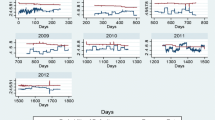Abstract
This paper examines whether the probability of default (Merton 1974) can be applied to banks’ default predictions. Using the case of US banks in the post-crisis period (2010–2014), we estimate several Cox proportional hazard models as well as their out-of-sample performance. As a result, we find that the Merton measure, that is, the probability of default, is not a sufficient statistic for predicting bank default, while, with the 6-month forecasting horizon, it is an extremely significant predictor and its functional form is a useful construct for predicting bank default. Findings suggest that (i) predicting banks’ defaults over a mid- to long-term horizon can be done more effectively by adding the inverse of equity volatility and the value of net income over total assets, and (ii) the role of the capital adequacy ratio is doubtful even in short-run default prediction.
Access this chapter
Tax calculation will be finalised at checkout
Purchases are for personal use only
Similar content being viewed by others
Notes
- 1.
In particular, Ji et al. [9] employed the time-varying volatility when calculating Merton’s DD and its extension, DC, by sampling the posterior distribution and proposed an early warning indicator using the difference between DD and DC.
References
Merton, R.C.: On the pricing of corporate debt: The risk structure of interest rates. J. Financ. 29(2), 449–470 (1974)
Hillegeist, S.A., Keating, E.K., Cram, D.P., Lundstedt, K.G.: Assessing the probability of bankruptcy. Rev. Acc. Stud. 9(1), 5–34 (2004)
Du, Y., Suo, W.: Assessing credit quality from equity markets: can a structural approach forecast credit ratings? Can. J. Adm. Sci. 24, 212–228 (2007)
Bharath, S.T., Shumway, T.: Forecasting default with the Merton distance to default model. Rev. Financ. Stud. 21(3), 1339–1369 (2008)
Campbell, J.Y., Hilscher, J., Szilagyi, J.: In search of distress risk. J. Financ. 63(6), 2899–2939 (2008)
Gropp, R., Vesala, J., Vulpes, G.: Equity and bond market signals as leading indicators of bank fragility. J. Money Credit Bank 38(2), 399–428 (2006)
Harada, K., Ito, T., Takahashi, S.: Is the distance to default a good measure in predicting bank failures? a case study of Japanese major banks. Jpn. World Econ. 27, 70–82 (2013)
Chan-Lau, J.A., Sy, A.N.: Distance–to–default in banking: a bridge too far? J. Bank. Regul. 9(1), 14–24 (2007)
Ji, G., Kim, D.S., Ahn, K.: Financial structure and systemic risk of banks: evidence from Chinese reform. Sustainability 11, 3721 (2019)
Expósito, R.R., Veiga, J., Touriño, J.: Enabling Hardware Affinity in JVM-Based Applications: A Case Study for Big Data. In: Krzhizhanovskaya, V.V., Závodszky, G., Lees, M.H., Dongarra, J.J., Sloot, P.M.A., Brissos, S., Teixeira, J. (eds.) ICCS 2020. LNCS, vol. 12137, pp. 31–44. Springer, Cham (2020). https://doi.org/10.1007/978-3-030-50371-0_3
Nagel, S., Purnanandam, A.: Banks’ risk dynamics and distance to default. Rev. Financ. Stud. 33(6), 2421–2467 (2020)
Fahlenbrach, R., Prilmeier, R., Stulz, R.M.: This time is the same: using bank performance in 1998 to explain bank performance during the recent financial crisis. J. Financ. 67(6), 2139–2185 (2012)
Cox, D.R., Oakes, D.: Analysis of Survival Data (Vol. 21). CRC Press. (1984)
Danielsson, J., Valenzuela, M., Zer, I.: Learning from history: Volatility and financial crises. LSE SRC Discussion Paper No 57 (2018)
Vassalou, M., Xing, Y.: Default risk in equity returns. J. Financ. 59(2), 831–868 (2004)
Acknowledgements
This research was supported by the Future-leading Research Initiative at Yonsei University (Grant Number: 2021–22-0306; K.A.).
Author information
Authors and Affiliations
Corresponding authors
Editor information
Editors and Affiliations
Rights and permissions
Copyright information
© 2022 The Author(s), under exclusive license to Springer Nature Switzerland AG
About this paper
Cite this paper
Jo, K., Choi, G., Jeong, J., Ahn, K. (2022). Forecasting Bank Default with the Merton Model: The Case of US Banks. In: Groen, D., de Mulatier, C., Paszynski, M., Krzhizhanovskaya, V.V., Dongarra, J.J., Sloot, P.M.A. (eds) Computational Science – ICCS 2022. ICCS 2022. Lecture Notes in Computer Science, vol 13350. Springer, Cham. https://doi.org/10.1007/978-3-031-08751-6_49
Download citation
DOI: https://doi.org/10.1007/978-3-031-08751-6_49
Published:
Publisher Name: Springer, Cham
Print ISBN: 978-3-031-08750-9
Online ISBN: 978-3-031-08751-6
eBook Packages: Computer ScienceComputer Science (R0)




